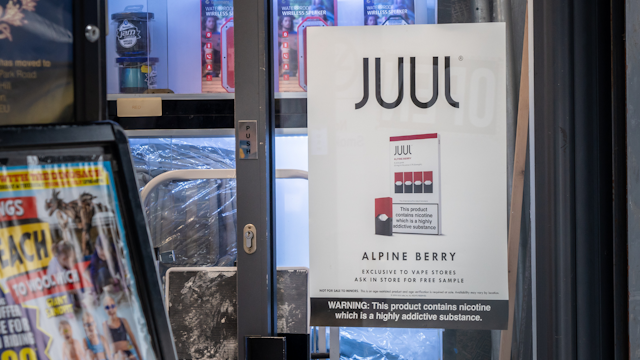Following Juul’s massive court settlement, will e-cigarette marketing get stubbed out?
E-cigarette giant Juul has agreed to a $40m settlement with the North Carolina Attorney General’s office over allegedly marketing to underage consumers. Now, the tobacco and e-cigarette industry is facing growing pressure to amend its marketing strategies — while both federal and state governments inch toward more stringent regulations for the industry. Here’s what you need to know.

Juul is caught amid a cloud of litigation
Juul, the brand whose very name has become synonymous with e-cigarettes and vaping, has witnessed an explosive growth in sales paired with growing backlash from regulators, interest groups and parents. Much like with regular cigarettes, concerns about the brand’s appeal to young people have led to lawsuits and an increasing spare of regulation coming down the pike.
The first shot of the bow is Juul’s agreement to pay $40m to the state of North Carolina in a lawsuit over the brand’s marketing, which the state argued targeted teens. It is the first major case levied against the company to close.
“This settlement is consistent with our ongoing effort to reset our company and its relationship with our stakeholders, as we continue to combat underage usage and advance the opportunity for harm reduction for adult smokers,” a Juul spokesperson tells The Drum. “Importantly, we look forward to working with [North Carolina] Attorney General Stein and other manufacturers on the development of potential industry-wide marketing practices based on science and evidence. In addition, we support the Attorney General’s desire to deploy funds to generate appropriate science to support North Carolina’s public health interventions to reduce underage use.”
Juul has not only grown exponentially since its inception in 2015 but has captured an immense share of the e-cigarette market — and the use of its products has become prolific among underage users. Research from Truth Initiative, a nonprofit organization focused on reducing teen use of tobacco products, found that 15- to 17-year-olds are 16 times more likely to use Juul compared to 25- to 34-year-olds. Further, over one-in-two youth and young adults who have ever used a Juul or an e-cigarette were under the age of 18 when they first tried the device.
Many credit of the brand’s rise in popularity to its successful marketing efforts.
Social media: the crown Juul of e-cigarette marketing
In numerous markets, including the UK and Australia, all tobacco-related advertising is explicitly banned. In the US, however, the First Amendment protects the right of companies to market its products to some degree or another. A 1970 decision by Congress barred tobacco advertising on television and radio in the US, as these were seen as “mass media” channels. In 1998, the tobacco Master Settlement Agreement introduced new restrictions, including limiting billboard advertising, the use of cartoon characters and brand endorsements by professional athletes.
“Gradually over time, tobacco marketing has been dialed back, although there's still an enormous amount of tobacco marketing today, particularly online and at the point-of -sale in convenience stores and gas stations,” says Dr. Robert Jackler, MD, a professor at Stanford University School of Medicine who has not only studied the rise of e-cigarette use among young people but also served as an expert on retainer for the North Carolina Attorney General’s office during the Juul case.

Today, there is also limited federal oversight of social media marketing of tobacco and e-cigarette products — something that Juul relied on to fuel its exponential growth between 2015 to early 2019, he says. “In its initial several years, its marketing was clearly an appeal to young people — not only the design of the advertising and messaging, but the channels they used. Its popularity among young people was largely driven by using the channel of organic social media marketing, because the major social media companies like Instagram, Facebook and Twitter don't allow paid promotion of tobacco products. However, Juul and others use organic social media by which they stimulated very strong interest amongst teenagers.”
Jackler notes that, in particular, Juul leveraged hashtag marketing to great effect, employing trending hashtags with millions of followers to drive traffic. It's also worth noting that the ubiquity of influencers may have contributed to the problem. In accordance with existing regulations, influencers are not permitted to post sponsored content from e-cigarette brands. But their original content — which may include tobacco- or e-cigarette-related imagery or messaging — may shape beliefs and actions of followers. Considering that 28% of people aged 16 to 23 across the globe follow influencers on social media, according to recent data from market research firm GWI, the ripple effect could be sizeable.
Current restrictions take hold
The recent North Carolina Attorney General decision includes a number of marketing restrictions to which Juul must adhere. Most of these policies, however, had already been adopted by the company prior to the decision, due to the growing pressure it had faced by interest groups as well as both local governing bodies and the US Congress. The company ceased selling flavored products besides menthol and stopped marketing its products via print and digital channels under the leadership of its newly-appointed chief executive K.C. Crosthwaite. Crosthwaite is a former executive at Altria, the parent company of Philip Morris USA, which owns a smattering of tobacco brands including Marlboro, Virginia Slims, and Parliament. Crosthwaite and others were brought onboard after Altria purchased a 38% stake in Juul in 2018 for a reported $12.8bn.
It’s important to note that the North Carolina decision does not prohibit all types of marketing, but creates limitations in the types of imagery, messaging and channels allowed. For instance, Juul cannot advertise on social media and must use older models in promotional imagery.
Even so, many would say that the restrictions spelled out by the North Carolina Attorney General don’t go far enough. “All forms of advertising, marketing, promotion, and sponsorship of tobacco products should be prohibited,” says Laurent Huber, executive director at Action on Smoking and Health, an independent interest group that seeks to publicize the harms associated with tobacco use. “All flavors should be removed from tobacco products to avoid enticing children and tobacco products should be highly regulated. It’s time to take steps to phase out the sale of commercial cigarettes because they kill their consumers when used as intended.”
In particular, underage use of the brand’s products is among the chief concerns of many of the federal, state and private lawsuits being leveraged against the brand today — and Jackler says there are thousands. “There's a huge overhang of litigation that clouds the future of the company and whether it's viable going forward,” he says.
The future of tobacco and e-cigarette regulation
While the North Carolina case is testament to states’ power to regulate the tobacco and e-cigarette industry, pressure is mounting in Washington to take more definitive action. Though the US Food and Drug Administration (FDA) was granted regulatory authority over the tobacco sector in 2009, it wasn’t until 2016 that the FDA was given rule over e-cigarettes. The agency regulates product attributes such as the level of nicotine in a given product and what flavors, if any, of vaporizable tobacco products, are allowed.
But the e-cigarette market, as it stands, is not subject to the same degree of extensive regulations that the cigarette and traditional tobacco market is — though that could change soon. In September of this year, the FDA will begin to review Premarket Tobacco Product Applications (PMTAs) for e-cigarette products. Juul filed its application last July in the form of a 110,000+ page document, which the company says includes scientific evidence that supports the assertion that its products have the potential to reduce harm compared to traditional cigarette usage. Its PMTA also outlines proposed approaches for reducing youth consumption.
Some don’t buy it. “Juul is going to continue to argue and advertise that e-cigarettes are ‘better’ than regular tobacco,” says Robert Passikoff, founder and president of market research firm Brand Keys. “They’re going to duck and weave until the FDA gets a lot tougher.”
And while the FDA exerts significant power over the tobacco sector, there is a good amount of action happening at the local and state levels, too. “A lot of tobacco regulations, like smoke-free restaurants and workplaces come from grassroots on a city-by-city and then state-by-state level,” says Jackler. “For example, several states and over 300 American cities now ban flavored e-cigarettes.” He also points out that while tobacco products are subject to taxation on the federal level, a growing number of states are adopting taxes for emerging tobacco products such as e-cigarettes into their taxation legislation. As it stands, Massachusetts and New York have among the most stringent regulations on tobacco and e-cigarette products.
While state and local governments have power over taxation, tobacco product flavor restrictions and much more, changes in marketing legislation will likely come from the federal level, says Jackler. While state and local governments share authority with the federal government over taxation, tobacco product flavor restrictions and much more, changes in marketing legislation will likely come from the federal level, says Jackler. The FDA was empowered by Congress to regulate tobacco products in 2009 and is presently considering a series of impactful measures which as reducing nicotine levels, banning menthol, limiting online sales and further constraining advertising messaging and channels.
What’s next for Juul?
Amid loudening cries for e-cigarette regulation, the tobacco industry has been quietly diversifying its portfolio to focus on non-combustible delivery systems. However, it’s not just the social and political pressure incentivizing the change. Jackler says that while smoking rates remain high in Eastern Europe, Southeast Asia and some other markets, these activities are declining in the US and Western Europe. Data from the FDA also suggests that e-cigarette usage among youth is falling in the US. From 2019 to 2020, past 30-day e-cigarette use among high school students fell from 27.5% to 19.6%, although this decline may be a transient pandemic-related effect.
With consumer habits evolving, tobacco and e-cigarette companies are investing in new product development. “They're finding other ways of sustaining addiction by delivering nicotine [orally or in other non-combustible ways],” Jackler says.
It’s unlikely that tobacco and e-cigarette companies will cease creating new nicotine-based products and finding ways to market them to consumers. It should be a priority for these companies to ensure that their promotional materials are in no way targeted to young people, Jackler says. “Advertising professionals understand who their ads target, and finding advertising methods that would appeal to the mature, middle-aged smoker, without appealing to teenagers, and choosing carefully the age-gating around delivery of the advertisements — not only at purchase, but delivery channels [will be critical].” He advises that restrictions on social media marketing should be the industry’s top concern. “And if the industry doesn't better police itself, there's going to be ever more restrictive governmental intervention,” he adds.
And Juul claims it’s well on its way. “We seek to continue to earn trust through action,” a company spokesperson says. “Over the past two years, for example, we ceased the distribution of our non-tobacco, non-menthol flavored products in advance of FDA guidance and halted all mass market product advertising. This settlement is another step in that direction.”

